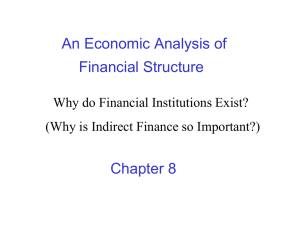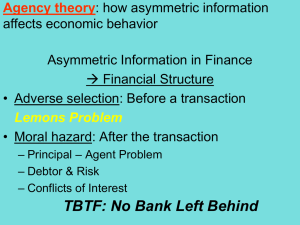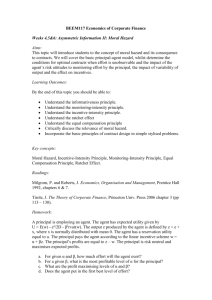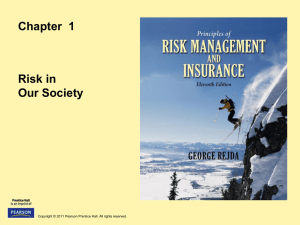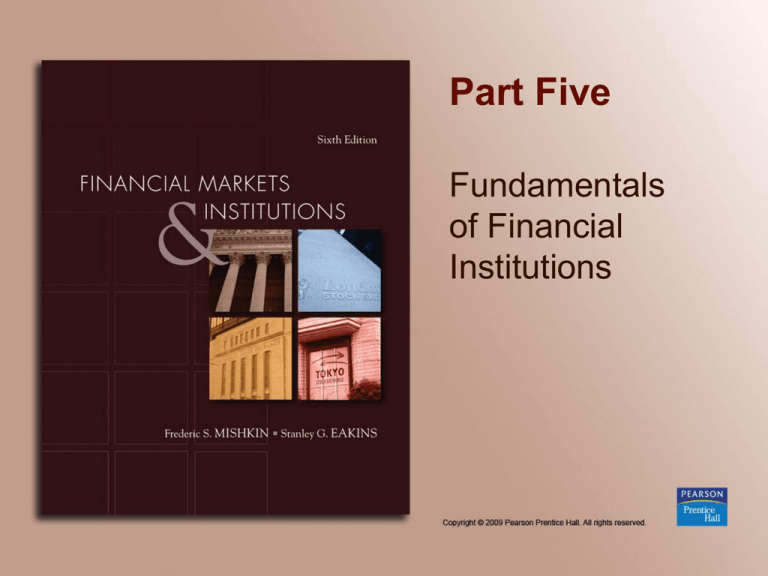
Part Five
Fundamentals
of Financial
Institutions
Chapter 15
Why Do Financial
Institutions Exist?
Chapter Preview
A vibrant economy requires a financial
system that moves funds from savers to
borrowers. But how does it ensure that
your hard-earned dollars are used by those
with the best productive investment
opportunities?
Copyright © 2009 Pearson Prentice Hall. All rights reserved.
15-3
Chapter Preview
In this chapter, we take a closer look at why
financial institutions exist and how they promote
economic efficiency. Topics include:
– Basic Facts About Financial Structure Throughout
the World
– Transaction Costs
– Asymmetric Information: Adverse Selection and
Moral Hazard
Copyright © 2009 Pearson Prentice Hall. All rights reserved.
15-4
Chapter Preview (cont.)
– The Lemons Problem: How Adverse Selection
Influences Financial Structure
– How Moral Hazard Affects the Choice Between
Debt and Equity Contracts
– How Moral Hazard Influences Financial
Structure in Debt Markets
– Financial Crises and Aggregate
Economy Activity
Copyright © 2009 Pearson Prentice Hall. All rights reserved.
15-5
Basic Facts About Financial Structure
Throughout the World
• The financial system is a complex structure
including many different financial
institutions: banks, insurance companies,
mutual funds, stock and bonds
markets, etc.
Copyright © 2009 Pearson Prentice Hall. All rights reserved.
15-6
Basic Facts About Financial Structure
Throughout the World
• The chart on the next slide show how
nonfinancial business attain external
funding in the U.S., Germany, Japan, and
Canada. Notice that, although many
aspects of these countries are quite
different, the sources of financing are
somewhat consistent, with the U.S. being
different in its focus on debt.
Copyright © 2009 Pearson Prentice Hall. All rights reserved.
15-7
Sources of Foreign External Finance
15-8
Data Source:China Annual Report on Financial and Futures Markets
9
Overall Scale to Be Further Enlarged
At the end of 2006, the total value of securities assets constituted only 22% of China’s total financial assets
Although this had increased to 37% by Sep 2007, the ratio remained relatively low and the overall scale of
China’s capital market is till small
10
Structure to Be Further Optimized
Relative size of bond and stock markets for selected countries (2007)
11
Facts of Financial Structure
1. Stocks are not the most important source
of external financing for businesses.
2. Issuing marketable debt and equity
securities is not the primary way in which
businesses finance their operations.
Copyright © 2009 Pearson Prentice Hall. All rights reserved.
15-12
Facts of Financial Structure
3. Indirect finance, which involves the activities of
financial intermediaries, is many times more
important than direct finance, in which
businesses raise funds directly from lenders in
financial markets.
4. Financial intermediaries, particularly banks, are
the most important source of external funds
used to finance businesses.
Copyright © 2009 Pearson Prentice Hall. All rights reserved.
15-13
Facts of Financial Structure
5. The financial system is among the most
heavily regulated sectors of economy.
6. Only large, well-established corporations
have easy access to securities markets to
finance their activities.
Copyright © 2009 Pearson Prentice Hall. All rights reserved.
15-14
Facts of Financial Structure
7. Collateral is a prevalent feature of debt
contracts for both households
and businesses.
8. Debt contracts are typically extremely
complicated legal documents that place
substantial restrictions on the behavior of
the borrowers.
Copyright © 2009 Pearson Prentice Hall. All rights reserved.
15-15
Transactions Costs
• Transaction costs: costs involved in doing
transactions; it includes information cost,
monitoring cost, contracting costs, and trading
costs such as commissions, bid-ask price spread,
and security transaction taxes.
• Transaction costs can hinder flow of funds to
people with productive investment opportunities
Copyright © 2009 Pearson Prentice Hall. All rights reserved.
15-16
Transactions Costs
• Financial intermediaries make profits by
reducing transactions costs
1. Take advantage of economies of scale
(example: mutual funds)
2. Develop expertise to lower
transactions costs
• which explains Fact # 3, the importance of
indirect finance (slide 15-10)
Copyright © 2009 Pearson Prentice Hall. All rights reserved.
15-17
Asymmetric Information: Adverse
Selection and Moral Hazard
• In your introductory finance course, you
probably assumed a world of symmetric
information—the case where all parties to a
transaction or contract have the same
information, be that little or a lot
• In many situations, this is not the case. We
refer to this as asymmetric information.
Copyright © 2009 Pearson Prentice Hall. All rights reserved.
15-18
Asymmetric Information: Adverse
Selection and Moral Hazard
• Asymmetric information can take on many
forms, and is quite complicated. However,
to begin to understand the implications of
asymmetric information, we will focus on
two specific forms:
– Adverse selection
– Moral hazard
Copyright © 2009 Pearson Prentice Hall. All rights reserved.
15-19
Asymmetric Information: Adverse
Selection and Moral Hazard
• Adverse Selection
1. Occurs when one party in a transaction has
better information than the other party
2. Before transaction occurs
3. Potential borrowers most likely to produce
adverse outcome are ones most likely to
seek loan and be selected
Copyright © 2009 Pearson Prentice Hall. All rights reserved.
15-20
Asymmetric Information: Adverse
Selection and Moral Hazard
• Moral Hazard
1. Occurs when one party has an incentive to
behave differently once an agreement is
made between parties
2. After transaction occurs
3. Hazard that borrower has incentives to
engage in undesirable (immoral) activities
making it more likely that won't pay
loan back
Copyright © 2009 Pearson Prentice Hall. All rights reserved.
15-21
Asymmetric Information: Adverse
Selection and Moral Hazard
• The analysis of how asymmetric
information problems affect behavior is
known as agency theory.
• We will now use these ideas of adverse
selection and moral hazard to explain how
they influence financial structure.
Copyright © 2009 Pearson Prentice Hall. All rights reserved.
15-22
The Lemons Problem: How Adverse Selection
Influences Financial Structure
•
Lemons Problem in Used Cars
1. If we can't distinguish between “good” and
“bad” (lemons) used cars, we are willing pay
only an average of good and bad car values
2. Result: Good cars won’t be sold, and the
used car market will function inefficiently.
•
What helps us avoid this problem with
used cars?
Copyright © 2009 Pearson Prentice Hall. All rights reserved.
15-23
The Lemons Problem: How Adverse Selection
Influences Financial Structure
•
Lemons Problem in Securities Markets
1. If we can't distinguish between good and bad
securities, willing pay only average of good
and bad securities’ value
2. Result: Good securities undervalued and
firms won't issue them; bad securities
overvalued so too many issued
Copyright © 2009 Pearson Prentice Hall. All rights reserved.
15-24
The Lemons Problem: How Adverse Selection
Influences Financial Structure
•
Lemons Problem in Securities Markets
3. Investors won't want buy bad securities, so
market won't function well
–
Explains Fact # 1 stocks and bonds are not
the most important source of financing and #
2 the importance of bank finance (slide 15-9)
–
Also explains Fact # 6 (slide 15-11): Less
asymmetric info for well known firms, so
smaller lemons problem
Copyright © 2009 Pearson Prentice Hall. All rights reserved.
15-25
Tools to Help Solve Adverse Selection
(Lemons) Problems
1. Private Production and Sale of Information
– Free-rider problem interferes with this solution
2. Government Regulation to Increase Information
(explains Fact # 5, financial sector is most
regulated, slide 15-11)
– For example, annual audits of public corporations
(although Enron is a shining example of why this
does not eliminate the problem – we’ll discuss that
briefly)
Copyright © 2009 Pearson Prentice Hall. All rights reserved.
15-26
Tools to Help Solve Adverse Selection
(Lemons) Problems
3. Financial Intermediation
– Analogy to solution to lemons problem
provided by used car dealers
– Avoid free-rider problem by making private
loans (explains Fact # 3 and # 4, the
importance of indirect finance such as
banks, slide 15-10)
– Also explains fact #6 – large firms are more
likely to use direct instead of indirect
financing
Copyright © 2009 Pearson Prentice Hall. All rights reserved.
15-27
Tools to Help Solve Adverse Selection
(Lemons) Problems
4. Collateral and Net Worth
– Explains Fact # 7, the importance of
collateral in debt, slide 15-12
Copyright © 2009 Pearson Prentice Hall. All rights reserved.
15-28
How Moral Hazard Affects the Choice
Between Debt and Equity Contracts
•
Moral Hazard in Equity Contracts:
the Principal-Agent Problem
1. Result of separation of ownership by
stockholders (principals) from control by
managers (agents)
2. Managers act in their own rather than
stockholders' interest
Copyright © 2009 Pearson Prentice Hall. All rights reserved.
15-29
How Moral Hazard Affects the Choice
Between Debt and Equity Contracts
An example of this problem is useful.
Suppose you become a silent partner in
an ice cream store, providing 90% of the
equity capital ($9,000). The other owner,
Steve, provides the remaining $1,000 and
will act as the manager. If Steve works
hard, the store will make $50,000 after
expenses, and you are entitled to $45,000
of it.
Copyright © 2009 Pearson Prentice Hall. All rights reserved.
15-30
How Moral Hazard Affects the Choice
Between Debt and Equity Contracts
However, Steve doesn’t really value the
$5,000 (his part), so he goes to the
beach, relaxes, and even spends some of
the “profit” on art for his office. How do
you, as a 90% owner, give Steve the
proper incentives to work hard?
Copyright © 2009 Pearson Prentice Hall. All rights reserved.
15-31
How Moral Hazard Affects the Choice
Between Debt and Equity Contracts
• Tools to Help Solve the Principal-Agent Problem
1.Production of Information: Monitoring
2.Government Regulation to Increase Information
3.Financial Intermediation (e.g, venture capital)
4.Debt Contracts
• Explains Fact # 1, slide 15-9: Why debt is used
more than equity
Copyright © 2009 Pearson Prentice Hall. All rights reserved.
15-32
How Moral Hazard Influences Financial
Structure in Debt Markets
• Even with the advantages just described,
debt is still subject to moral hazard. In fact,
debt may create an incentive to take on
very risky projects. This is important to
understand. Let’s looks at a simple
example.
Copyright © 2009 Pearson Prentice Hall. All rights reserved.
15-33
How Moral Hazard Influences Financial
Structure in Debt Markets
• Most debt contracts require the borrower to pay a
fixed amount (interest) and keep any cash flow
above this amount.
• For example, what if a firm owes $100 in interest,
but only has $90? It is essentially bankrupt. The
firm “has nothing to lose” by looking for “risky”
projects to raise the needed cash.
Copyright © 2009 Pearson Prentice Hall. All rights reserved.
15-34
How Moral Hazard Influences Financial
Structure in Debt Markets
•
Tools to Help Solve Moral Hazard in
Debt Contracts
1. Net Worth
2. Monitoring and Enforcement of
Restrictive Covenants. Examples are covenants
that …
1.
discourage undesirable behavior
2.
encourage desirable behavior
3.
keep collateral valuable
4.
provide information
5.
Dividend restrictions
6.
Restrictions on new debt issuing
Copyright © 2009 Pearson Prentice Hall. All rights reserved.
15-35
How Moral Hazard Influences Financial
Structure in Debt Markets
•
Tools to Help Solve Moral Hazard in
Debt Contracts
3. Financial Intermediation—banks and other
intermediaries have special advantages
in monitoring
•
Explains Facts # 1–4, stocks are not the most important
sources of financing, debt and banks are more
important, slides 15-9 & 15-10
Copyright © 2009 Pearson Prentice Hall. All rights reserved.
15-36
Asymmetric Information Problems and
Tools to Solve Them
15-37
Financial Crises and Aggregate
Economic Activity
Our analysis of the effects of adverse
selection and moral hazard can also assist
us in understanding financial crises, major
disruptions in financial markets. Then end
result of most financial crises is the inability
of markets to channel funds from savers to
productive investment opportunities.
Copyright © 2009 Pearson Prentice Hall. All rights reserved.
15-38
Financial Crises and Aggregate
Economic Activity
•
Factors Causing Financial Crises
1. Problems in banking sector
2. Government Fiscal Imbalances and resulting higher
interest rate
3. Balance of payments problems
4. Burst of asset bubbles
•
As shown in the next slide, most U.S. financial crises
have begun with a deterioration in banks’ balance
sheets.
Copyright © 2009 Pearson Prentice Hall. All rights reserved.
15-39
Case: U.S. Financial Crisis
• The U.S. has a long history of banking and
financial crises, dating back to 1819. Our
analysis can explain why these took place
and why they were so damaging.
• The next figure outlines the events leading
to a financial crisis.
Copyright © 2009 Pearson Prentice Hall. All rights reserved.
15-40
Case: The Great Depression
• In 1928 and 1929, stock prices doubled in the
U.S. The Fed tried to curb this period of
excessive speculation with a tight monetary
policy. But this lead to a collapse of stock market
more than 60% in October of 1929.
• Further, between 1930 and 1933, one-third of
U.S. banks went out of business
Copyright © 2009 Pearson Prentice Hall. All rights reserved.
15-42
Case: The Great Depression
• Adverse selection and moral hazard in
credit markets became severe. Firms with
productive uses of funds were unable to get
financing. The prolonged economic
contraction lead to an unemployment rate
around 25%.
Copyright © 2009 Pearson Prentice Hall. All rights reserved.
15-43
Asian Financial Crisis
• High short-term foreign debt used to finance longterm domestic projects (double mis-match)
• High leverage and asset bubbles
• Governance problems in both public sector and
private sector
• Serious real impact: lost of output, Japan, 17.6%,
Malaysia, 50%, South Korea 50.1%, Indonesia
67.9%, Thailand 97.7% of 1997 GDP
Copyright © 2009 Pearson Prentice Hall. All rights reserved.
15-44
Asian Financial Crisis: Hong Kong
• Linked Exchange Rate System since 1983
• Strong economy but asset bubbles
• Attack of hedge funds such as Quantum
Funds of George Soros
• Defense of HK government
– Initial stage: raise inter-bank lending rate
– Second stage: direct intervention in stock
market
Copyright © 2009 Pearson Prentice Hall. All rights reserved.
15-45
Asian Financial Crisis: China
• Similar problems such as weakness in
financial systems, high leverage in
corporations, large non-performing loans,
lax regulations
• But relative less short-term foreign debt
• Restrictions on capital account
• Not devaluate its RMB during the crisis and
played a stable role
Copyright © 2009 Pearson Prentice Hall. All rights reserved.
15-46
2007-credit crisis
• Started in the beginning of 2007 and deepened
in September 2008
• From sub-prime crisis to credit crisis
Sub-prime
MBS
AAA Bond
Sold worldwide
$1.3 triilion,total
home loan 12
trillion,GDP 14
trillion
CDS
Rating Company
CDS
market 65
trilion
• Declining real estate price since 2006 due to higher
interest since 2004
Factors contribute to the crisis
1.
Policy failures
-lax monetary policy since 2001
-Government intervention in real estate market
*Freddie Mac and Fannie Mae dominates MBS
* Interest deduction for home loans
* American dream, encourage home ownership, even for low-income people
-Deregulation since Regan years
2. Market failures
-“Greedy bankers” excessive lending
-excessive financial engineering and innovations
* 400 trillion derivatives market, including 65 trillion CDS market, while the total corporate
bond market is 26 trillion
* AIG insures about 440 billion CDS
* Although Bear Stearns only has 190 billion debt, the CDS for it is 2 trillion
-corporate governance in financial institutions: conflict of interests between shareholders(principal)
and managers (agent)





